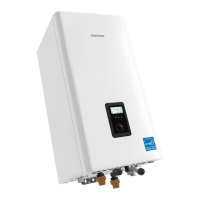Note
●
When PCB DIP switch 2 #8 is set to On, ensure that
CPVC, polypropylene, or stainless steel is used for
exhaust venting.
●
This unit may be installed at elevations up to 10,100
ft (3,078 m) for use with natural gas and propane. To
use the unit at a specific altitude, the DIP switches
should be set as described above.
●
High Altitude: Above 2,000 ft (610 m), the unit will
de-rate by 3% for each 1,000 ft (305 m) of altitude
gain.
●
For NG, if you install the unit at above 5,400 ft (1,646
m), it is required to change the Gas Orifice for high
altitude. Be careful not to confuse it with the LP Gas
Orifice. Refer to “4.4 Gas & High Altitude Conversion”
on page 25 for details.
●
Common vent installations for use with natural gas
and propane are only approved for up to 4,500 ft.
CAUTION
Ensure that the High Altitude setting reflects the actual
location of the boiler. If not, it may cause personal injury or
malfunction of the boiler.
4.3 Measuring the Inlet Gas Pressure
WARNING
The boiler cannot function properly without sufficient inlet
gas pressure. Measuring the inlet gas pressure should be
performed by a licensed professional only.
●
The inlet gas pressure must be maintained between 3.5 in and
10.5 in WC for natural gas and between 8.0 in and 13.5 in WC for
liquefied propane.
●
The appliance and its individual shutoff valve must be
disconnected from the gas supply piping system during any
pressure testing of that system at test pressures in excess of
1
/
2
psi (3.5 kPa).
●
The appliance must be isolated from the gas supply piping
system by closing its individual manual shutoff valve during
any pressure testing of the gas supply piping system at test
pressures equal to or less than
1
/
2
psi (3.5 kPa).
To measure the inlet gas pressure:
1. Shut off the manual gas valve on the gas supply line.
Gas Valve
Opened Closed
2. Turn on the boiler. On the front panel, press the Back button
( ) and the Menu button ( ) simultaneously for 3 seconds,
and then rotate the Command dial (
) to move to “7. Special
Operations”.

